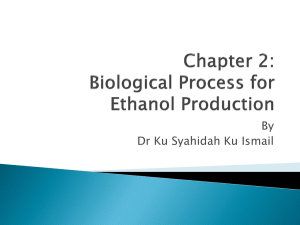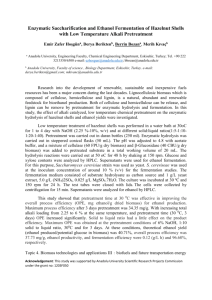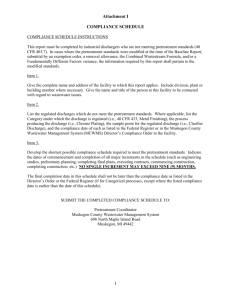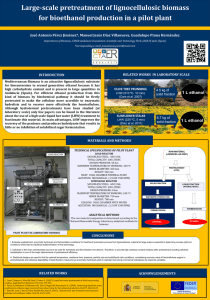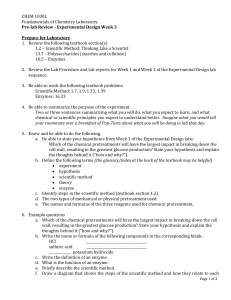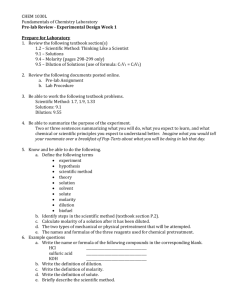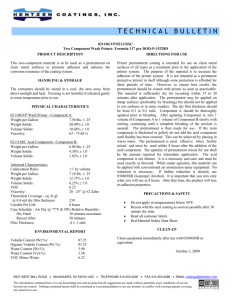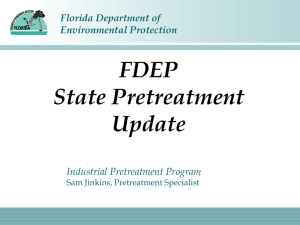1. Goals and Objectives
advertisement
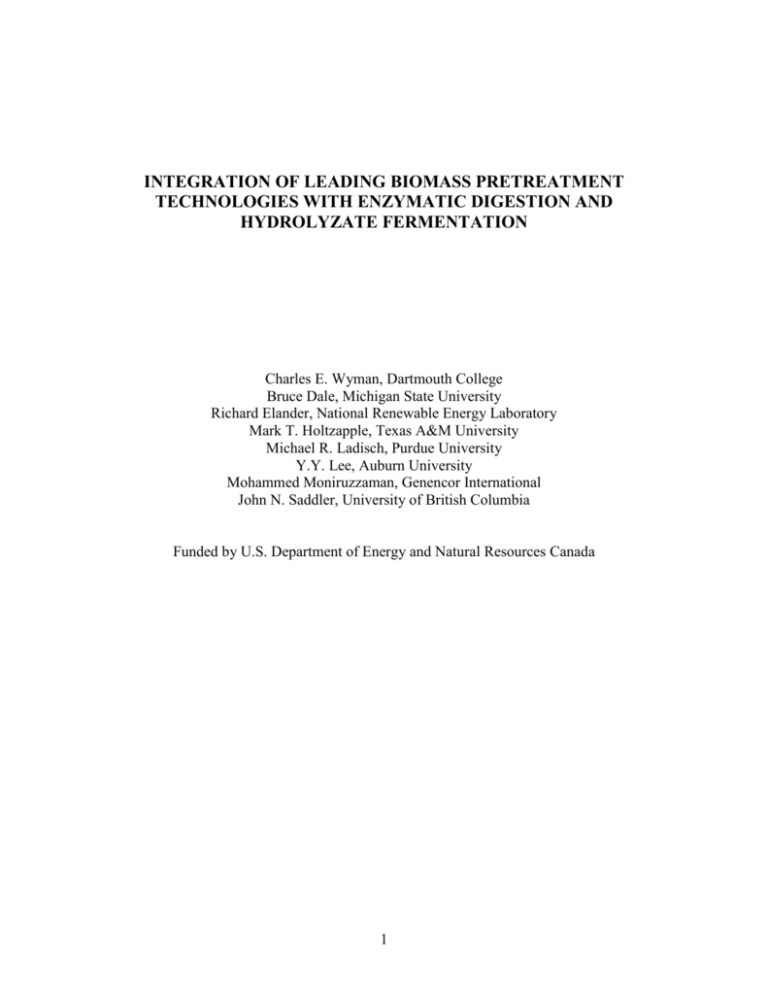
INTEGRATION OF LEADING BIOMASS PRETREATMENT TECHNOLOGIES WITH ENZYMATIC DIGESTION AND HYDROLYZATE FERMENTATION Charles E. Wyman, Dartmouth College Bruce Dale, Michigan State University Richard Elander, National Renewable Energy Laboratory Mark T. Holtzapple, Texas A&M University Michael R. Ladisch, Purdue University Y.Y. Lee, Auburn University Mohammed Moniruzzaman, Genencor International John N. Saddler, University of British Columbia Funded by U.S. Department of Energy and Natural Resources Canada 1 1. GOALS AND OBJECTIVES The goal of the project is to develop and compare leading biomass pretreatment technologies coupled with fermentation and enzymatic digestion. We also seek to better understand interactions among pretreatment, fermentation, and enzymatic hydrolysis to gain insight that will facilitate selection and commercialization of cellulosic technologies and lead to step change cost reductions. Another goal is to train and educate students in biomass technologies. Corn stover will be used to tie to previous research funded by the USDA IFAFS Program, but the team will focus primarily on poplar, a leading woody energy crop, coupled with fermentation and enzymatic hydrolysis. It is also proposed that the team work closely with Genencor International, a leading manufacturer of cellulase and other enzymes, to apply commercial and new state-of-the-art enzyme formulations in this research. Although the fermentation portion focuses on ethanol, the results should be valuable to making other products. The objectives of the proposed project are as follows: 1. Cellulosic biomass will be pretreated by leading technologies to improve cellulose accessibility to enzymes. 2. Conditioning methods will be developed as needed to maximize fermentation yields by a recombinant yeast, the cause of inhibition will be determined, and fermentations will be modeled. 3. Cellulose and hemicellulose in pretreated biomass will be enzymatically hydrolyzed, as appropriate, and models will be developed to understand the relationship between pretreated biomass features, advanced enzyme characteristics, and enzymatic digestion results. 4. Capital and operating costs will be estimated for each integrated pretreatment, hydrolysis, and fermentation system and used to direct research. 5. The proposal team will work with an Industrial and Agricultural Advisory Board and others to evaluate these findings; identify opportunities to utilize the pretreatment technologies; define opportunities to improve coupled pretreatment, fermentation, and enzymatic hydrolysis; and disseminate the results widely. 2. PROPOSED RESEARCH APPROACH Biomass conversion experts from Dartmouth College; Auburn, Michigan State, Purdue, and Texas A&M Universities; the National Renewable Energy Laboratory (NREL); the University of British Columbia; and Genencor International will collaborate on this project. The first 7 are members of a Biomass Consortium on Applied Fundamentals and Innovation (CAFI) formed in early 2000, and the first 6 are completing coordinated research through USDA IFAFS support to develop comparative data and economics for pretreatment of corn stover by leading technologies. That project is also improving the understanding of these pretreatments and establishes analytical procedures as well. It is proposed to expand this approach to hardwood, an important feedstock class with different characteristics than stover that NREL will provide from a maintained source. However, our focus will shift toward understanding in more depth the effects of leading pretreatments on fermentation and enzymatic hydrolysis and applying this insight to improve pretreatment. Dartmouth College will lead the overall project that would be conducted in elements corresponding to each project objective. Each element will be led by a team member but will use other team members to take advantages of their talents. Element 1: Pretreat cellulosic biomass by leading technologies. Michigan State University (MSU) will be responsible for this element of dilute acid, SO2, controlled pH, AFEX, ARP, flowthrough, and lime pretreatment. All participants already have the experimental systems and procedures needed in place. For the first, NREL will provide liquid hydrolyzate and pretreated cellulose samples from their facilities based on extensive experience with poplar. They will also apply their new technology to prepare hot water washed dilute acid treated cellulose with improved digestibility. The University of British Columbia will provide pretreated solids and hydrolyzate for poplar pretreated with SO2 in their steam gun at conditions they defined before. Purdue will make hydrolyzates and pretreated solids by their controlled pH pretreatment method. Because AFEX has not been applied extensively to poplar, MSU will require more time to define conditions to maximize both cellulose digestibility and total hemicellulose and cellulose sugar recovery. Based on results from the USDA IFAFS funded CAFI project with corn stover, the approximate AFEX 2 treatment ranges expected include temperatures of 60-110 0C, sample moisture content of 50-150% on a dry weight basis, ammonia to dry sample loadings of 0.5 – 1.5 kg ammonia/kg dry sample, and times of 5-15 minutes, but research is needed to determine what conditions will work for poplar. Models will be developed to relate AFEX performance to these variables. Based on prior results, AFEX is expected to remove little lignin or hemicellulose. Auburn University has shown through USDA IFAFS support that lignin removal by their ARP process improves enzymatic hydrolysis of corn stover, and comparing the digestibility of cellulose from ARP and AFEX pretreated solids will provide insight into the effects of exposure of lignin to ammonia versus lignin removal by ammonia on enzymatic hydrolysis. Auburn will also evaluate whether their new approach to reducing ammonia and water use with corn stover through IFAFS funding will work as well for hardwood. In addition, kinetic models will be developed to describe hemicellulose and lignin removal. Dartmouth has applied flowthrough pretreatment to remove up to 70% of lignin and all hemicellulose without addition of any chemicals or use of very dilute sulfuric acid (<0.1%). Although known approaches use too much water to be economically viable, flowthrough recovers virtually all hemicellulose sugars and produces highly digestible cellulose. The latter is thus a low lignin substrate for comparison to lignin removal with ammonia via ARP. Finally, lime has also been shown to remove large amounts of lignin, and Texas A&M will treat poplar wood with lime to provide a substrate for comparison to lignin removal via ARP and flow. MSU’s responsibility will include monitoring the application of procedures applied in previous CAFI research to insure accurate mass balance closure. Auburn University will assist MSU by insuring all analytical work to determine solids carbohydrate content (glucan, xylan, arbinan, mannan, and galactan), Klason lignin, extractables, ash in solids, and sugars and soluble lignin in liquids is performed according to established or modified protocols. These analyses will include differentiating hydrolytic from reversion and decompositions reactions and reactions with lignin for dilute acid and flowthrough pretreatments. Element 2: Develop conditioning methods and ferment hydrolyzates with a recombinant fermentative organism. Purdue University will lead this element to develop and understand both conditioning and fermentations of pretreatment hydrolyzates. First, they will apply additional analyses to identify total dissolved solids, organic acids, furfural, and 5-hydroxymethyl furfural (HMF) in liquid streams from pretreatments and enzymatic hydrolysis of pretreated solids based on NREL laboratory analytical procedures (LAPs). However, some modifications will be made such as using a HPX-87H instead of a HPX-87C column to concurrently determine acetic acid released from hemicellulose and sugar degradation products formed in pretreatment. Although not all biological inhibitors have been identified, this information will help understand how known inhibitors change with pretreatment approach. Purdue will develop conditioning methods as needed to improve fermentability to ethanol using their genetically engineered Saccharomyces cerevisiae strain (17). Overliming, widely used to prepare dilute acid hydrolyzates, will be used as a baseline. However, based on Purdue’s experience, polymeric, hydrophobic resins will be tested, and their adsorption and desorption properties determined over varying furfural and HMF concentrations at temperatures of 20 to 80°C and contact times up to equilibrium. Analytical liquid chromatography data will be used to determine kinetics and Langmuir constants for continuous chromatographic adsorption models. Model predictions will be confirmed using large scale continuous chromatographic columns for on-off removal and regeneration that will also provide conditioned liquid for fermentation tests. In contrast to other pretreatments, it is expected the AFEX material will require no conditioning. Genetically engineered Saccharomyces strain 424A(LNH-ST) will be used to ferment conditioned and unconditioned hydrolyzates in 300 ml baffled Erlenmeyer flasks in Dr. Ho’ s laboratory at Purdue (17). The yeast will be pre-grown in 100 ml YEPD (1% yeast extra, 1% peptone, and 2% glucose) and transferred into 100 ml of hydrolyzate supplemented with 10 ml 10 % yeast extract. Flasks will be sealed with Saran wrap to allow fermentation under largely anaerobic conditions, and samples taken every 6 hrs. Glucose, xylose, ethanol, and xylitol concentrations will be analyzed by HPLC to determine how the presence and concentration of inhibitors affects fermentation. The conditioning approach will be modified as possible to improve ethanol yields. Data from successful fermentations will be used to develop models 3 to relate rates and yields of fermentation to inhibitor concentrations and to the types and concentrations of sugars. Such models will be valuable in understanding how well we can account for inhibition and in applying and improving fermentation and conditioning technologies. Element 3: Characterize and model relationship between pretreated solids features and advanced enzyme properties and apply to improve pretreatments and enzymes. Dartmouth College will lead this portion of the project with help from Texas A&M. First, pretreated solids from Element 1 will be hydrolyzed with cellulase and hemicellulase to measure changes in hydrolysis performance with pretreatment conditions and mixtures of these two enzymes with the goal of solubilizing over 90% of residual cellulose and hemicellulose in pretreated solids to sugars. Genencor, a major supplier and developer of cellulase and hemicellulase, will review team results and supply commercial and advanced formulations to improve performance. Use of cellulase loadings of 15 and 60 FPU/g cellulose in straight hydrolysis and SSF fermentations will be applied per NREL LAP methods. Results will also be continuously supplied to researchers in Element 1 to modify pretreatment conditions to improve results. Texas A&M will lead characterization of solids at optimum or near optimum overall sugar recovery for pretreatment and enzymatic hydrolysis for each pretreatment to determine how crystallinity, acetylation, hemicellulose and lignin removal, degree of polymerization of cellulose, and other features vary among pretreatments and conditions. The ability of a model they developed previously to relate enzymatic digestibility to these features will be evaluated and modified as needed to more accurately describe performance. The results will help us better understand the effect of pretreated substrate features on digestibility. Dartmouth College will lead research on understanding the relationship of cellulase action to balance of activities and interactions with pretreated biomass. Results from the initial digestion and substrate characterization portions of this Element will help narrow the effort from many possible choices to pretreated substrates that promise better insight. Dartmouth will work with Genencor to measure how performance is altered with changes in the levels and sources of endoglucanase, exoglucanase, and βglucosidase for the different pretreatments to determine whether pretreatment type affects optimal activity balances. Research will also be directed at measuring cellulase adsorption by pretreated solids from different pretreatments using established methods practiced by team members and others, and data will be developed on adsorption of cellulose on washed lignin recovered after enzymatic digestion to determine whether pretreatment affects non-productive cellulase binding (8). Work will be included on whether treating residual lignin with ammonia affects cellulase adsorption, as mentioned briefly in the literature. Kinetic models will be developed based on hydrolysis data, enzyme adsorption, and pretreated solids features to aid in understanding pretreatment/cellulase interactions. The University of British Columbia (UBC) will lead research that targets breakdown of residual hemicellulose in solids following pretreatment using hemicellulases supplied by Genencor. This research is particularly important for AFEX, ARP, and lime pretreatments that leave a large fraction of residual hemicellulose. Thus, Michigan State, Auburn, and Texas A&M will work closely with UBC. However, enzymatic release of sugars from residual hemicellulose and oligomers following dilute acid and SO2 pretreatment could allow use of less severe conditions and improve overall hemicellulose sugar yields, and UBC will coordinate this research with NREL as well. Hemicellulase activities, loadings, substrate features, and performance will be related, and fundamental models will be developed to relate performance to substrate and enzyme features. This research will be integrated with that on cellulase to determine if cellulase and hemicellulase actions are interrelated or independent. Element 4: Estimate capital and operating costs for each integrated pretreatment, hydrolysis, and fermentation system and use to guide project. NREL will be responsible for a comparative economic analysis of leading pretreatment options based on technical results from the proposed work. NREL process engineers have developed baseline models for conversion of biomass to ethanol for each pretreatment through DOE funding for the existing USDA IFAFS funded CAFI project. In cooperation with the CAFI team, NREL will modify and refine these ASPEN based material and energy balance models based on hardwood results from the proposed project. In addition, capital and operating costs will be estimated based on NREL’s extensive cost database. These models will focus on making ethanol from 4 biomass, but most of the operations, and therefore implications, are applicable to biological production of other products. The result will provide insight on how each pretreatment technology affects costs when integrated into a representative process. This approach will also help us identify important technical issues that impact cost and could impede applications and provide valuable insight that will allow us to better target our research as new results are produced. Element 5: Work with Industrial and Agricultural Advisory Board and others in execution, dissemination, application, and advancement of integrated pretreatment systems. Dartmouth College will be responsible for assembling an Advisory Board for the project. This portion will build off the Advisory Board assembled for the USDA IFAFS funded project that has representatives from 16 companies including existing large processing companies (e.g., Dupont and Cargill), start up companies (Cargill Dow and Applied Carbochemicals), agriculture organizations (e.g., National Corn Growers Association), consultants (e.g., CEA), and enzyme companies (e.g., Genencor and Novozymes). This combination of advisors will provide diverse perspectives on the interests of industry and agriculture that should help us better focus research. We propose to continue conference calls among the research team twice a month in which each team member on a rotating basis presents informal written reports provided via email to the team, and these reports are forwarded on to the Advisory Board to keep them apprised of progress. We also plan to continue our current practice of meeting with the Advisory Board in May and November of each year in conjunction with the Annual Symposium on Biotechnology for Fuels and Chemicals and National AIChE meeting, respectively, to review progress and seek suggestions on promising directions and opportunities. These interactions plus email correspondence also facilitate management of the project to include tracking progress and costs. An important goal is to disseminate our results widely to facilitate commercial decisions and further research, and the team will work closely with the Advisory Board and others to identify audiences with interest in applying the technical and economic results and approaches to contact such parties. For example, consideration will be given to sending letters to each party identified to notify them of the project, the participants, and the approach being taken. Such a letter could provide information on contacting the team for data and analysis. The team will also prepare a final report summarizing comparative data, economics, and modeling results to serve as a basis for several presentations and peer reviewed papers in the literature. 5

